So much has happened since I last posted that it’s hard to know where to begin in terms of the strange new world we are living in at present.
My own journey to isolation started in Yorkshire. At the time it seemed safe to travel and to go ahead with our two-week holiday, but that weekend everything changed in terms of both the political and public attitude to the Coronavirus pandemic. Northern railway stations such as Leeds and York, usually so crowded you had to fight your way to the platforms, were completely deserted. Trains were cancelled as drivers self-isolated. We made it to Ilkley and walked on the Moors as much as we could before deciding it would be better to cut our losses and come home. Five days later, safely home in Norfolk, we were in Lockdown.

Ilkley was a great little town, the High Street flanked with blossoming trees and the moors looming at the end of the road. Darwin was a fan of this area and would surely have loved its prehistory. Once on the moors it does feel like a different world, there are stones marked with neolithic carvings (see the Swastika Stone below) scattered all over the rough terrain, craggy brooks and a rather enigmatic stone circle called The Twelve Apostles which might, or might not, be ancient. The views from every point are sweeping, one way to Leeds, the other way to the Three Peaks – the weather was mockingly good throughout as we started planning our return.
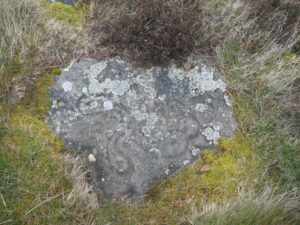
There are far worse places to be locked down than East Runton. We are very fortunate that our favourite local walks are all within the somewhat confused remit of one-a-day exercise as they all start the minute we step out of our front door. It’s a time to appreciate the little things and to celebrate what we have access to. I’m a Skype convert and have chatted to friends in Denmark and The Netherlands as well as having a virtual glass of wine with my best friend in London a couple of times a week.
It’s a time to be inventive with food too – infrequent supermarket trips mean there’s plenty of opportunity to delve into the back of the storecupboard and transform that slightly out of date chickpea flour into onion bhajis and calentica (a kind of North African pancake mix which I used to have a lot when I was in Paris in the 80s). It might be time to try and make nettle soup too – we have so many locally and it’s been on my radar for a while!

Then there are the projects. We’ll be working our way through our DVD box set of Wagner’s The Ring – my favourite opera(s). I can’t describe the feeling when the first notes of Das Rheingold rumble out – primeval. Foolish actions almost leading to the end of the world – perhaps not such a strange choice… Chris has dusted off a 10-hour History of Reggae from Mento to Lover’s Rock by Linton Kwesi Johnson so I might be a far better bet in pub quizzes from now on! I rarely buy hardbacks but splashed out on Hilary Mantel’s The Mirror and the Light having so much enjoyed the first two books of her Cromwell Trilogy. As a writer I am in awe at how she makes the characters’ speak so naturally, and how she does this without using quote marks but the reader is never confused. I’ve also bought Atwood’s The Testaments and two Ada Limón poetry collections Bright Dead Things and The Carrying – beautifully accessible poetry. And Chen Chen’s When I Grow Up I Want to be a List of Further Possibilities. Check out both these poets at the wonderful Poetry Foundation website:
https://www.poetryfoundation.org/poets/ada-limon
https://www.poetryfoundation.org/poets/chen-chen
So, now to the sheep and the goats! One of my previous blogposts featured the gorgeous Kashmiri goats of Great Orme, the rocky outcrop which looms into the sea and starts in the town of Llandudno. Well, these goats are now international stars – a YouTube sensation. Since the lockdown they have started to come into Llandudno and run riot. They always ventured down in the past but now there are no humans to chase them back up to the hills. Check out this article with accompanying video.
One of the most interesting things about the global lockdown has been the effect on nature. I’ve been reading about Malthus, the nineteenth century economist and demographer. His theory is that if one species becomes too dominant then nature will find a way of redressing the balance. As we stay local for a few weeks and consume and travel less, there’s a neat bit of rewilding going on – less pollution, more birdsong. There have been lots of news items about nature taking back Venice as the waterways become clearer.
There’s a very interesting writing project called Postcards from Malthusia which might be of interest:
https://newbootsandpantisocracies.wordpress.com/
Nature has always been prevalent on our favourite local walk. It only takes 40 minutes but at the moment, in terms of what you can see in the Springtime, it feels epic!
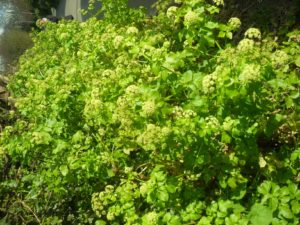
The walk starts with a hedgerow full of glowing lime-green alexanders. These edible plants were introduced to the UK by the Romans and known as the “pot plants of Alexandria” – every bit of the plant is edible and it’s often known as Roman celery. It has a beautiful sweet scent, a bit like elderflower, and a tangy sap. It’s too pretty to forage, but you never know…
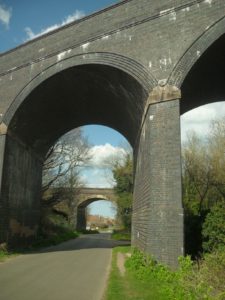
Then, under the double-viaduct that separates the village into Top Common and Lower Common. It was built in 1902 to bring holidaymakers to the coast from all parts of the country.
At this stage we always do a quick double-check to see if there are still nine classic white farmyard geese hanging out like bored teenagers on the green (there were twelve when we moved here).
Then on to Manor Farm which is just like the kind of farm you’d have as a kid, a little bit of everything – donkeys, sheep, lambs, hens, a cockerel, Muscovy ducks, sometimes goats, the occasional horse.

Up the road to check on the lambs. In just a few days they have become more solid, less leggy and much calmer, less inclined to do their Harrier Jump Jet VSTOL (Vertical Short Take Off and Landings) leaps. I can’t help thinking about military planes when I see these lambs. Well, I do come from Kingston-upon-Thames where British Aerospace had their factory and it was almost mandatory to work there for a bit – I temped there for two summers and both my then boyfriend and my brother did their apprenticeships there.
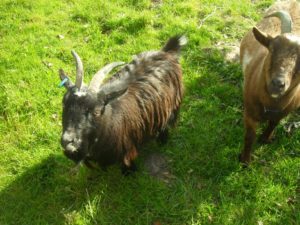 Down the green lane to the pygmy goats. These are hilarious. I seem to have perfected some kind of fake Swiss yipping yodel which brings them running, bells clanking and I can get them to follow me along the fence line to the next gate. The goat whisperer!
Down the green lane to the pygmy goats. These are hilarious. I seem to have perfected some kind of fake Swiss yipping yodel which brings them running, bells clanking and I can get them to follow me along the fence line to the next gate. The goat whisperer!
Then along the lane with views to Cromer Ridge and Incleborough Hill to the crossroads and back towards the village via the Big House and Britain’s first Montessori School. Quick recount of the geese, back under the viaduct and home. It’s a lovely walk, never tedious, always full of wildlife (buzzards wheeling, a green woodpecker calling) and wildflowers (the celandine are particularly beautiful at the moment).
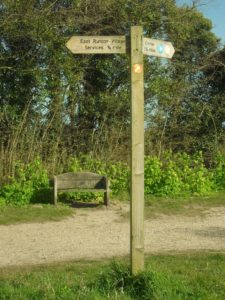
On a pre-lockdown walk in February we took a friend up the Hill to see the Bagot goats who were overwintering here before being let loose on Cromer cliffs to do their bit as live lawnmowers. I gather they are now self-isolating on Salthouse Heath but hopefully there’ll be a bit of Summer for us all, with a bit of the Old Normal seeping back into our lives. Until then, stay safe everyone…
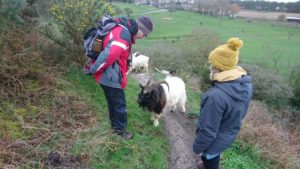

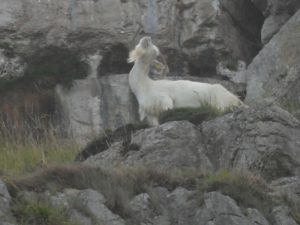
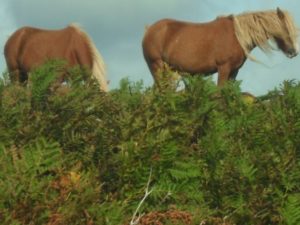
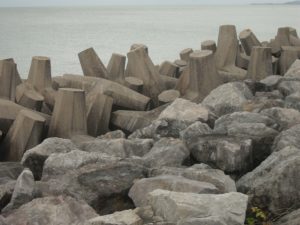



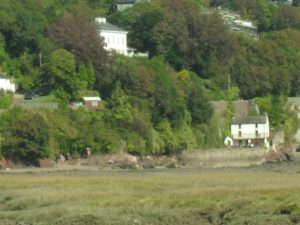
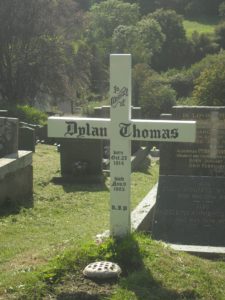


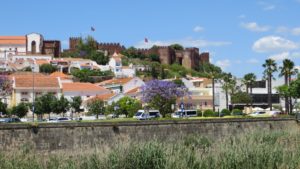
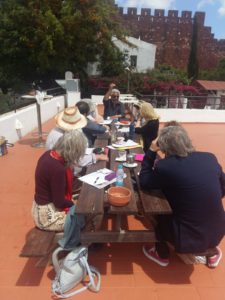
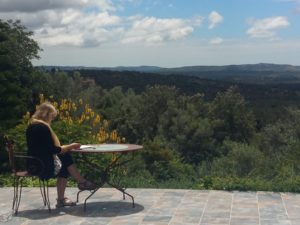 multiple guises, unpindownable…
multiple guises, unpindownable…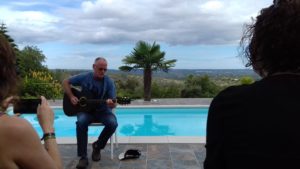
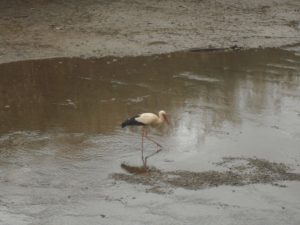
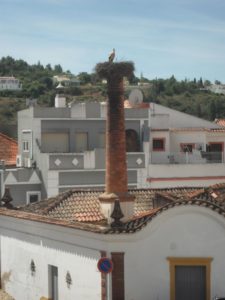
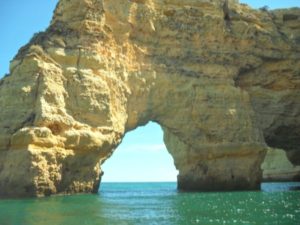
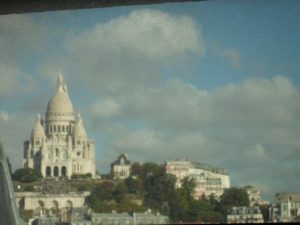








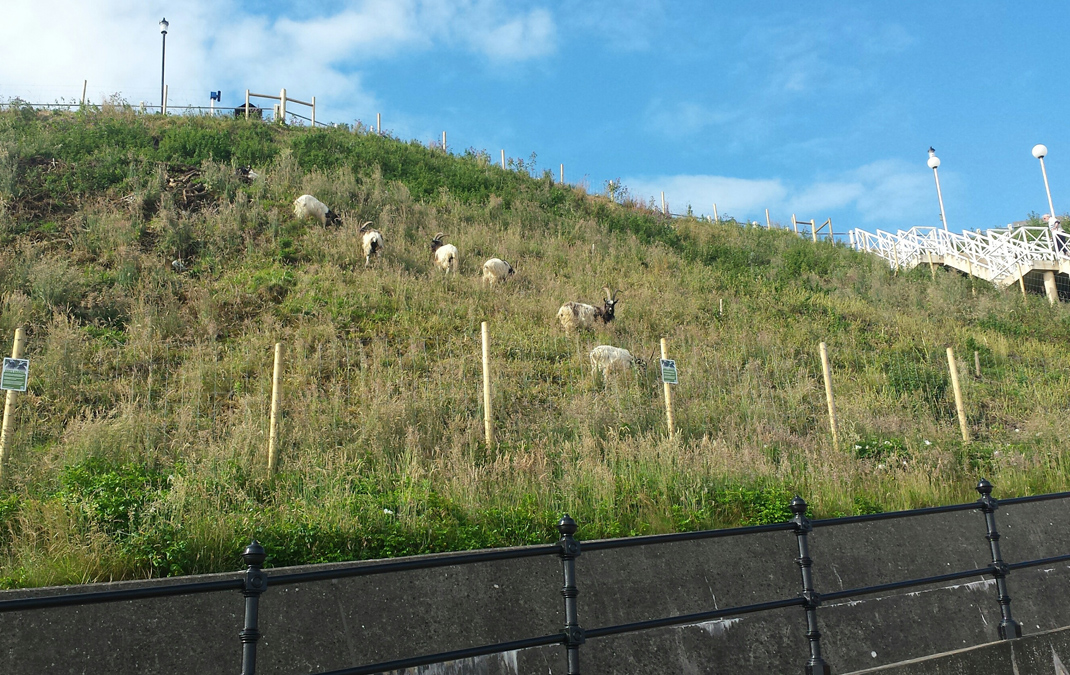
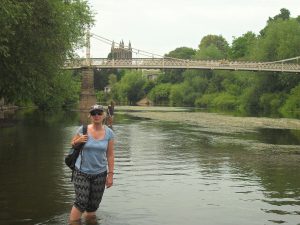
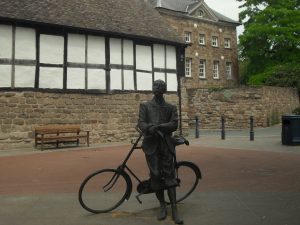


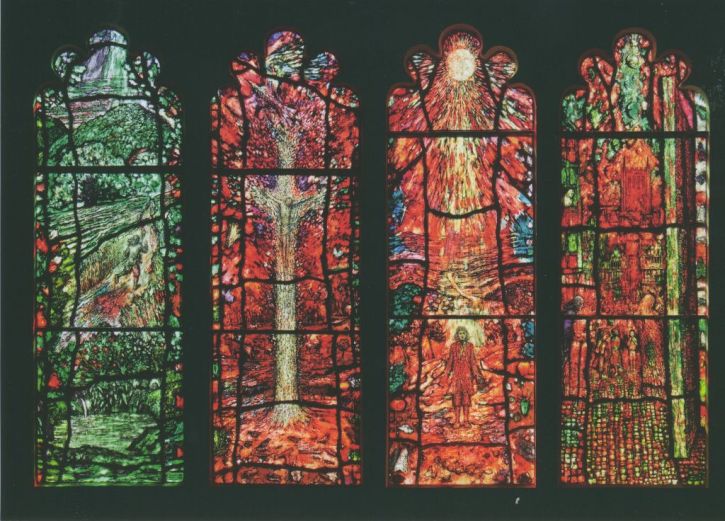
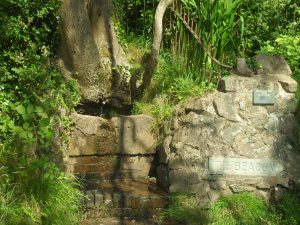


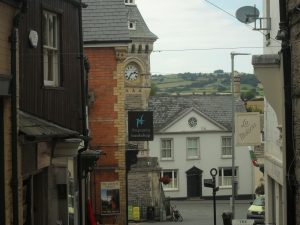

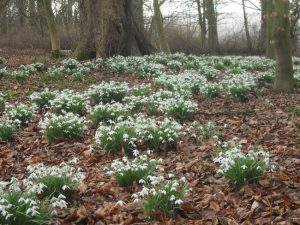


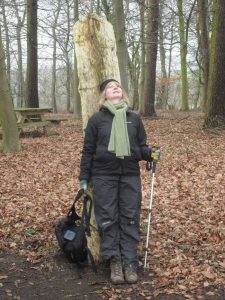
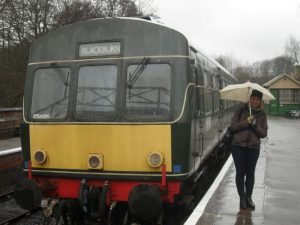





 Now I’m resident in East Runton and just down the road from Cromer, this, of course, is my new favourite pier. It’s one of only five UK piers with a working theatre and I’m very much looking forward to booking my ticket for the End of the Pier show! The pier itself has had a long and rich history with records of a structure going back as far as the fourteenth century. At night it’s lit up in a magical way and acts as my beacon when I walk along the beach to Cromer on dark evenings.
Now I’m resident in East Runton and just down the road from Cromer, this, of course, is my new favourite pier. It’s one of only five UK piers with a working theatre and I’m very much looking forward to booking my ticket for the End of the Pier show! The pier itself has had a long and rich history with records of a structure going back as far as the fourteenth century. At night it’s lit up in a magical way and acts as my beacon when I walk along the beach to Cromer on dark evenings. The pier was the location for “In love with Alma Cogan” directed by Tony Britten. Much of the action took place in the Pavilion Theatre and the plot revolved round Theatre Manager Norman’s resistance to a more commercial show. Norman was played by Roger Lloyd Pack and the film was one of his last appearances on screen. Lloyd Pack was well loved locally, he’d fallen in love with the area in the 1970s after acting in Joseph Losey’s The Go Between alongside Alan Bates and Julie Christie and, as a result, owned a house locally.
The pier was the location for “In love with Alma Cogan” directed by Tony Britten. Much of the action took place in the Pavilion Theatre and the plot revolved round Theatre Manager Norman’s resistance to a more commercial show. Norman was played by Roger Lloyd Pack and the film was one of his last appearances on screen. Lloyd Pack was well loved locally, he’d fallen in love with the area in the 1970s after acting in Joseph Losey’s The Go Between alongside Alan Bates and Julie Christie and, as a result, owned a house locally.
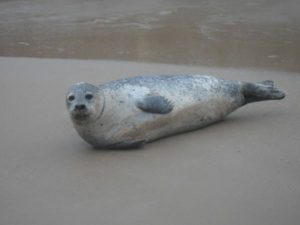
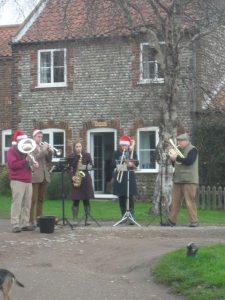 They were three generations of the same family raising money for Parkinsons Disease. The whole village turned out, there were hugs and kisses and Christmas greetings and children who’d decided to stay in the warm calling out of top-floor windows. It all felt very cosy and Miss Marple, hopefully without the murders! Another of my favourite screen depictions of a village is Bramley End in Cavalcanti’s thought-provoking 1942 film for Ealing Studios Went the Day Well. Based on Graham Greene’s short story The Lieutentant Died Last, this was a propaganda film designed to alert the country about the dangers of being complacent about the possibility of invasion. In the film, the villagers of Bramley End are far too trusting and are overrun by Nazi paratroopers posing as an English battalion. There’s a cast of much-loved 1940s actors – Leslie Banks, Thora Hird (in her first major role), Harry Fowler, Mervyn Johns, Valerie Taylor, Patricia Hayes, Basil Sydney… The village (actually the very pretty Turville in Buckinghamshire) is shown as an English rural idyll, depicting very successfully what we were fighting to preserve.
They were three generations of the same family raising money for Parkinsons Disease. The whole village turned out, there were hugs and kisses and Christmas greetings and children who’d decided to stay in the warm calling out of top-floor windows. It all felt very cosy and Miss Marple, hopefully without the murders! Another of my favourite screen depictions of a village is Bramley End in Cavalcanti’s thought-provoking 1942 film for Ealing Studios Went the Day Well. Based on Graham Greene’s short story The Lieutentant Died Last, this was a propaganda film designed to alert the country about the dangers of being complacent about the possibility of invasion. In the film, the villagers of Bramley End are far too trusting and are overrun by Nazi paratroopers posing as an English battalion. There’s a cast of much-loved 1940s actors – Leslie Banks, Thora Hird (in her first major role), Harry Fowler, Mervyn Johns, Valerie Taylor, Patricia Hayes, Basil Sydney… The village (actually the very pretty Turville in Buckinghamshire) is shown as an English rural idyll, depicting very successfully what we were fighting to preserve.

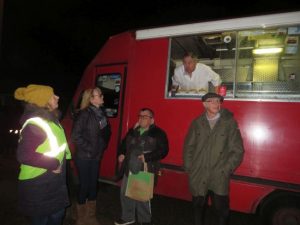


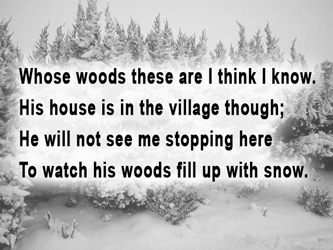
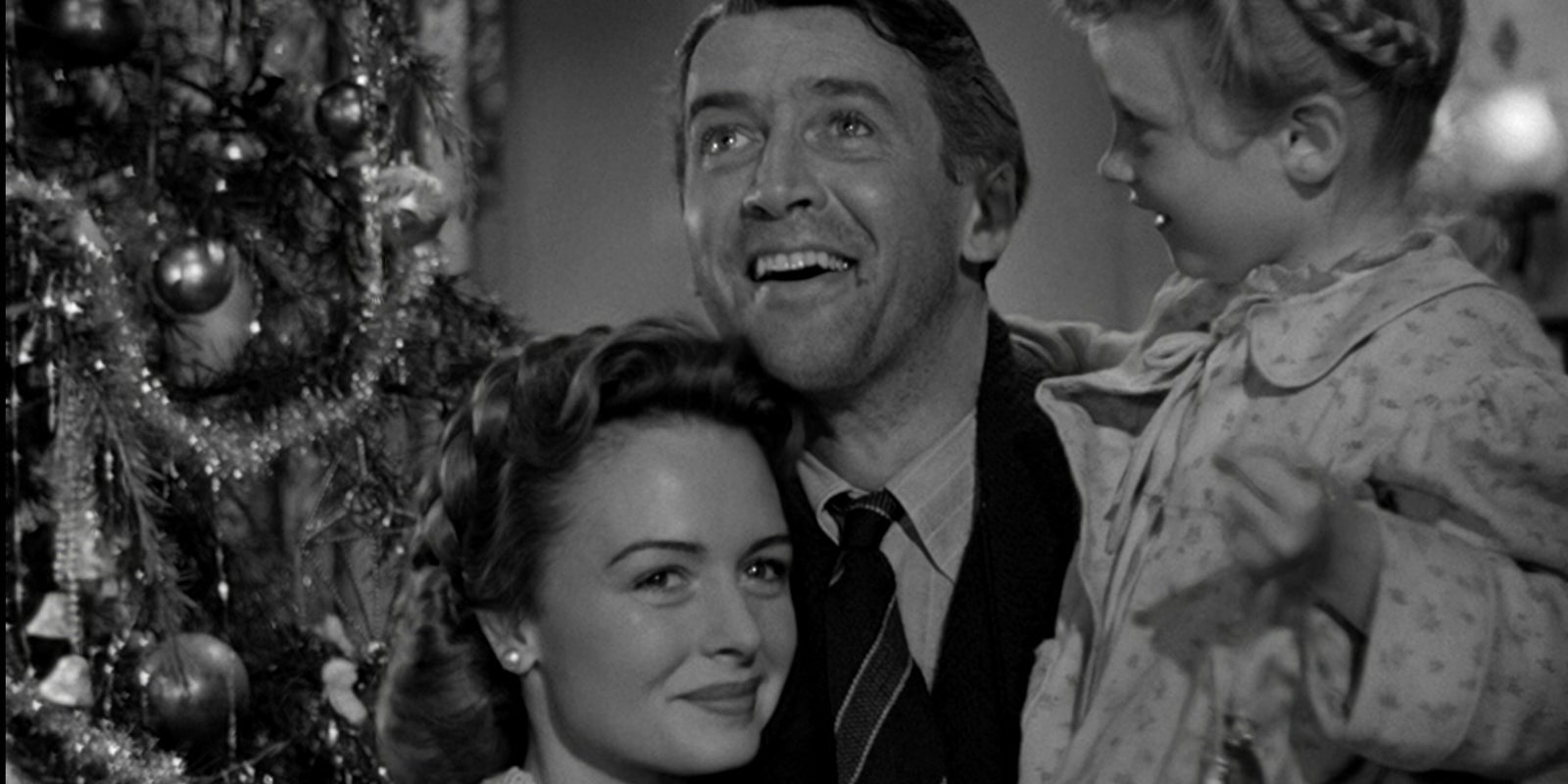 I do, of course, spend quite a bit of time watching Christmas films. I’m sure we all enjoy creating our own traditions at Christmas and for us Christmas Day can’t start until we’ve watched It’s a Wonderful Life (1946) late on Christmas Eve. I always cry at the end, even after multiple viewings. James Stewart as George Bailey, in debt and trouble through no fault of his own, wants to die. Clarence, the angel who’s trying to get his wings, rescues him by showing him what life would be like if there were no George Bailey. It’s really a re-telling of Dickens’ A Christmas Carol, with Mr Potter as the evil banker – the bad side of Scrooge, and George Bailey as the benign banker who Scrooge later becomes. Clarence is all the ghosts of Christmas past, present and future wrapped into one as he shows George the impact he has had on everyone. The film has to be watched in conjunction with my favourite version of A Christmas Carol, the 1951 version with Alistair Sim as a fabulously histrionic Scrooge, although The Muppet Christmas Carol is a close second! Paddington, voiced by the inimitable Ben Whishaw, is fast becoming a Christmas favourite. I’ve been very interested in the discussions in the press discussing Paddington 2 and referencing Paddington as our outlet for Brexit frustration. He is the classic immigrant and the various attitudes of the community towards him reflect our somewhat divided nation at the moment.
I do, of course, spend quite a bit of time watching Christmas films. I’m sure we all enjoy creating our own traditions at Christmas and for us Christmas Day can’t start until we’ve watched It’s a Wonderful Life (1946) late on Christmas Eve. I always cry at the end, even after multiple viewings. James Stewart as George Bailey, in debt and trouble through no fault of his own, wants to die. Clarence, the angel who’s trying to get his wings, rescues him by showing him what life would be like if there were no George Bailey. It’s really a re-telling of Dickens’ A Christmas Carol, with Mr Potter as the evil banker – the bad side of Scrooge, and George Bailey as the benign banker who Scrooge later becomes. Clarence is all the ghosts of Christmas past, present and future wrapped into one as he shows George the impact he has had on everyone. The film has to be watched in conjunction with my favourite version of A Christmas Carol, the 1951 version with Alistair Sim as a fabulously histrionic Scrooge, although The Muppet Christmas Carol is a close second! Paddington, voiced by the inimitable Ben Whishaw, is fast becoming a Christmas favourite. I’ve been very interested in the discussions in the press discussing Paddington 2 and referencing Paddington as our outlet for Brexit frustration. He is the classic immigrant and the various attitudes of the community towards him reflect our somewhat divided nation at the moment.

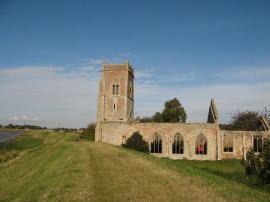
 I’ve just finished The River by Olivia Laing which follows the course of another Ouse, the one in Sussex in which Virginia Woolf took her life in 1941 wearing her heaviest coat, pockets full of stone. It’s a depressing but fascinating book, Laing had just split up with her partner and her sense of anxiety and unease permeates every step as she walks alone in deep contemplation. Occasionally Laing launches herself into the water to cool down and revitalise, these are disturbing moments during which she seems to have little regard for her safety and I held my breath until the next page, willing her to survive. I’ve just reviewed Elizabeth Jane Burnett’s Swims (Penned in the Margins). This powerful collection is a long poem documenting twelve wild swims across the UK’s rivers, lakes and seas. Each poem is an experiment, pushing at the page, seeking freedom from its confines and I thoroughly enjoyed the inventiveness of it. The thought of wild swimming entrances me and I’m even thinking of investing in a wetsuit for all year round sea swimming. Swimming is where I plan my writing workshops and solve poetic problems – that tricky last line, what to leave out, the perfect twist for a line, the revelation of the ideal form to fit the content of the poem – it’s as if the beat of my arms and legs sets up a problem-solving rhythm.
I’ve just finished The River by Olivia Laing which follows the course of another Ouse, the one in Sussex in which Virginia Woolf took her life in 1941 wearing her heaviest coat, pockets full of stone. It’s a depressing but fascinating book, Laing had just split up with her partner and her sense of anxiety and unease permeates every step as she walks alone in deep contemplation. Occasionally Laing launches herself into the water to cool down and revitalise, these are disturbing moments during which she seems to have little regard for her safety and I held my breath until the next page, willing her to survive. I’ve just reviewed Elizabeth Jane Burnett’s Swims (Penned in the Margins). This powerful collection is a long poem documenting twelve wild swims across the UK’s rivers, lakes and seas. Each poem is an experiment, pushing at the page, seeking freedom from its confines and I thoroughly enjoyed the inventiveness of it. The thought of wild swimming entrances me and I’m even thinking of investing in a wetsuit for all year round sea swimming. Swimming is where I plan my writing workshops and solve poetic problems – that tricky last line, what to leave out, the perfect twist for a line, the revelation of the ideal form to fit the content of the poem – it’s as if the beat of my arms and legs sets up a problem-solving rhythm.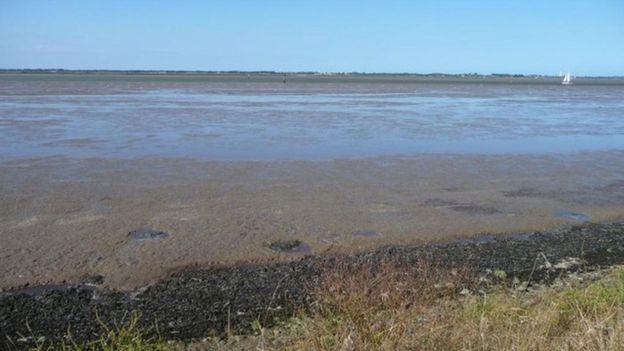 Another favourite river walk is the Nar Valley Way. We’ve walked from Gressenhall (near the source) back to Narborough several times and have done the Narborough to King’s Lynn stretch too. It’s more valley than river, although the river does pop up in surprising places along the way. My favourite stretch is Narborough to Castle Acre. Early on in the walk there’s a distant view of Narford Hall, seat of the Fountaines, where in the 1960s Andrew Fountaine, founder member of the BNP created an annual Aryan camp. Or perhaps we’re better off remembering Margaret Fountaine of South Acre, diarist, lepidopterist and explorer in an era (1890s onward) when this was just not “done”, especially as it seems that the much-travelled Margaret may have had an “affectionate relationship” with her guide and trasnlator of 27 years, Khalil Neimy. The large number of monastic ruins strewing the countryside are a great feature of the walk, all found near clean flowing water to meet the monks’ needs. Walking past The Stag at West Acre and then down to the Fords, you get tantalising glimpses of the ruined priory of West Acre before crossing the water meadows and coming out at the ruins of Castle Acre, a Cluniac Priory dating back to 1090.
Another favourite river walk is the Nar Valley Way. We’ve walked from Gressenhall (near the source) back to Narborough several times and have done the Narborough to King’s Lynn stretch too. It’s more valley than river, although the river does pop up in surprising places along the way. My favourite stretch is Narborough to Castle Acre. Early on in the walk there’s a distant view of Narford Hall, seat of the Fountaines, where in the 1960s Andrew Fountaine, founder member of the BNP created an annual Aryan camp. Or perhaps we’re better off remembering Margaret Fountaine of South Acre, diarist, lepidopterist and explorer in an era (1890s onward) when this was just not “done”, especially as it seems that the much-travelled Margaret may have had an “affectionate relationship” with her guide and trasnlator of 27 years, Khalil Neimy. The large number of monastic ruins strewing the countryside are a great feature of the walk, all found near clean flowing water to meet the monks’ needs. Walking past The Stag at West Acre and then down to the Fords, you get tantalising glimpses of the ruined priory of West Acre before crossing the water meadows and coming out at the ruins of Castle Acre, a Cluniac Priory dating back to 1090.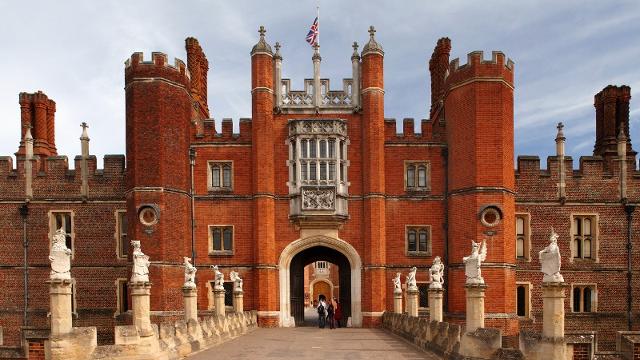 I guess it’s no suprise that I’m so attracted to rivers. My father was a boatbuilder and I grew up in Kingston-upon-Thames so the river was always a strong presence through my formative years. At the end of the road where I lived for most of my childhood was the Hogsmill, a tributary of the Thames which, one memorable evening, overflowed – I remember my mother furiously sweeping it back under the door. Kingston was well situated for visits to Kew Gardens on the bus with twopence entry posted in the honesty box. I would walk along the Thames to Hampton Court where under sixteens could get in for a couple of shillings. It’s probably here that my love of history began as I devoured Jean Plaidy and stood with my eyes closed in the Haunted Gallery where Catherine Howard is said to have begged Henry for her life, hoping to hear her cries.
I guess it’s no suprise that I’m so attracted to rivers. My father was a boatbuilder and I grew up in Kingston-upon-Thames so the river was always a strong presence through my formative years. At the end of the road where I lived for most of my childhood was the Hogsmill, a tributary of the Thames which, one memorable evening, overflowed – I remember my mother furiously sweeping it back under the door. Kingston was well situated for visits to Kew Gardens on the bus with twopence entry posted in the honesty box. I would walk along the Thames to Hampton Court where under sixteens could get in for a couple of shillings. It’s probably here that my love of history began as I devoured Jean Plaidy and stood with my eyes closed in the Haunted Gallery where Catherine Howard is said to have begged Henry for her life, hoping to hear her cries.
 And if tea really isn’t your tipple of choice then head back to Cambridge and check out Hot Numbers on Trumpington Street, just past the Fitzwilliam. This roastery and cafe really does know its beans, specialising in single origin coffee. I’ve had the most layered and tasty coffees ever here so do give it a try!
And if tea really isn’t your tipple of choice then head back to Cambridge and check out Hot Numbers on Trumpington Street, just past the Fitzwilliam. This roastery and cafe really does know its beans, specialising in single origin coffee. I’ve had the most layered and tasty coffees ever here so do give it a try!